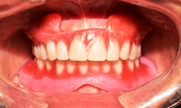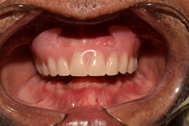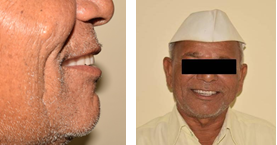Case Report
Volume 2 Issue 6 - 2018
Prosthodontic Rehabilitation for Severe Labial Undercut with Modified Flange Design
1Post Graduate Student, Rural Dental College, PMT, Loni, India
2Professor and HOD, Dept. Of Prosthodontics, Rural Dental College, PMT, Loni, India
3Associate Professor, Dept. Of Prosthodontics, Rural Dental College, PMT, Loni, India
4Post Graduate Student, Rural Dental College, PMT, Loni, India
2Professor and HOD, Dept. Of Prosthodontics, Rural Dental College, PMT, Loni, India
3Associate Professor, Dept. Of Prosthodontics, Rural Dental College, PMT, Loni, India
4Post Graduate Student, Rural Dental College, PMT, Loni, India
*Corresponding Author: Divya Toshniwal, Post Graduate student, Dept. Of Prosthodontics
Rural Dental College, PIMS, Loni, Maharashtra, India.
Received: March 24, 2018; Published: April 05, 2018
Abstract
Complete denture prosthesis is still a preferred choice for rehabilitation in dentistry. After the extraction of maxillary anterior teeth when severe labial undercuts are present, the conventional complete denture may not give desired esthetics and comfort. This case report describes a nonsurgical treatment option for edentulous patients with severe labial undercut in the anterior maxilla.
Key words: Modified flange; Flangeless; Denture design; Severe undercut; Labial undercut
Introduction
The presence of labial undercut in edentulous maxillary arch poses challenge to the prosthodontist for development of good esthetics along with comfort and function. Hard tissue undercuts are most commonly available mechanical means of retention in completely edentulous patients. Tissue undercuts ranging from moderate to severe must undergo surgical correction for reduction of the undercuts. Removal of severe undercuts in the form of pre-prosthetic surgery is considered as an essential mouth preparation before complete denture fabrication. [1] Patients should be made aware in such cases how surgical procedures will help for future denture wearing. [2,3]
Excessively prominent ridge is more commonly seen in maxilla than in mandible. Removal of the minimum amount of bone necessary to eliminate the undercut, while at the same time avoiding the loss of bony cortical plate can be done for such conditions in order to improve the environment for denture construction. [4]
Few patients may not agree to undergo surgical correction. In few the systemic conditions may not allow it. In such patients distinctive technique can be followed in order to fabricate a prosthesis which will be esthetically pleasing and acceptable for the patient. Since the surface area available for denture construction in maxilla is twice as that in the mandible, the modification in labial flange of maxillary denture is not critical for denture retention.
Case Report
A 67 years old patient reported to the Department of Prosthodontics, Rural Dental College and Hospital, Loni with the complaint of missing teeth in upper and lower jaw since 6 months and wanted replacement for the same.
He had ovoid face and convex profile. Intra oral examination revealed U-shaped maxillary and mandibular arches, high well rounded ridges, labially inclined premaxilla, and accompanying severe labial undercut. Patient’s refusal for the pre prosthetic treatment modality of alveoloplasty led to the construction of a complete denture with non-surgical treatment option.
In the presence of large labial undercut, the conventional complete denture would result in unesthetic labial fullness. So to fulfil the esthetic demands of the patient a flangeless complete denture was planned. Till the try-in clinical step the standard procedure for denture construction was followed. The maxillary labial flange was modified in the trial denture in the region of undercut (Figure 1 and 2). Patient’s high lip line was favourable for the modified design of the flange. Enhancement in the esthetics was appreciated by both operator and patient. Patients consent was gained for the flangeless design. The denture construction was done in conventional manner. After ascertaining the retention, stability, support and occlusion the denture insertion procedure was completed. Patient appreciated the esthetics of modified flange design (Figure 3 and 4). Importance of denture hygiene in the modified flange area was emphasized to the patient apart from the regular post denture insertion instructions. Patient was recalled periodically and evaluated for the comfort.
Conclusion
Flangeless design of the complete denture is a good alternative for surgical correction of labial undercut to enhance esthetics, provided all other factors of complete denture success are favourable.
References
- Obwegeser H. “Surgical Preparation of the Maxilla for Prosthesis.” Journal of Oral and Maxillofacial Surgery 22 (1964): 127-134.
- Hillerup S. “Preprosthetic surgery in the elderly”. The Journal of Prosthetic Dentistry 72.5 (1994): 551-558.
- Nandita KN., et al. “Modified flange complete denture for labially inclined premaxilla”. Indian Journal of Dental Advancements 2.2 (2010).
- Lawson WA. “Objectives of pre-prosthetic surgery”. British Journal of Oral Surgery 10 (1973): 175-188.
Citation:
Toshniwal., et al. “Prosthodontic Rehabilitation for Severe Labial Undercut with Modified Flange Design”. Oral Health and
Dentistry 2.6 (2018): 499-501.
Copyright: © 2018 Toshniwal., et al. This is an open-access article distributed under the terms of the Creative Commons Attribution License, which permits unrestricted use, distribution, and reproduction in any medium, provided the original author and source are credited.






































 Scientia Ricerca is licensed and content of this site is available under a Creative Commons Attribution 4.0 International License.
Scientia Ricerca is licensed and content of this site is available under a Creative Commons Attribution 4.0 International License.